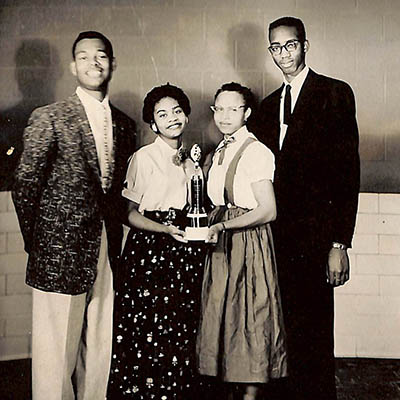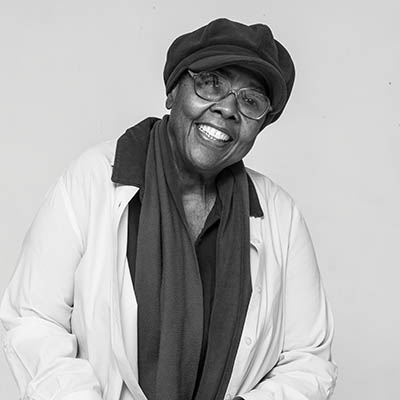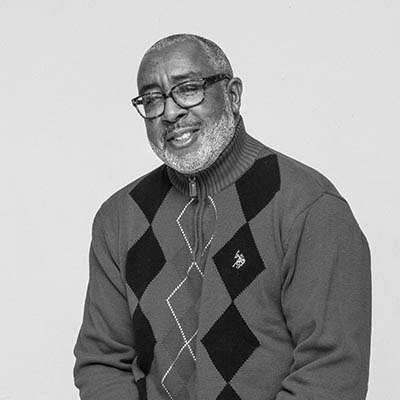Manual for living
Remembering Muskogee’s all-black high school
The cast of “The Adorable Imp,” presented in the 1950s by the junior class at Manual Training High School.
Muskogee Public Library
Robert Gray’s high school insecurities had nothing to do with the fact that he was black, or that he attended a segregated campus where the textbooks were usually several years old.
“I wasn’t that popular,” he said. “I was a little shy, because I was small. I was only about 5 feet, 2 inches tall my senior year. The girls didn’t want a little short guy.”
Football and basketball stardom weren’t really in the cards, so he became a trainer. He was a good baseball player, though getting suited up was a problem his freshman year.
“They didn’t have uniforms small enough for someone like me, so I had to wear the smallest pair of football pants they had.”
But vertical challenges aside, Gray said it was a wonderful thing to be a member of the class of 1968 at Muskogee’s Manual Training High School.
“The main thing was just the camaraderie,” he said. “You knew everyone. We were like one large family.”
Manual prepared him well for college and for life, said Gray, who retired from the City of Tulsa in 2015.
“Everybody stressed education, that no one could hold you back once you’ve got knowledge.”
He majored in accounting at Northeastern State University in Tahlequah and later earned a master’s degree in business administration. And he got his growth spurt the summer after graduation from Manual, shooting up to just over 6 feet tall.
“Our motto at Manual was SESEP—which stood for social, emotional, spiritual, economic and physical,” Gray said.
“We’ve never settled for less,” said Perline Boyattia, who graduated in 1969. “We are overcomers, and we’ve never looked back.”
“Nurturing” is the word retired educator Cedric Johnson uses to describe the campus atmosphere. Boyattia agreed.
“We didn’t realize how tough it was to be black until we became adults,” she said. “We were in a bubble.”
 Achieving against the odds
Achieving against the odds
The children of Muskogee’s first African American residents were educated primarily at churches. In 1898 the Muskogee school board was formed, and Dunbar Public School was created for black students through grade eight.
Manual Training High School opened in 1910 and graduated its first senior class in 1912.
“Without any of the fanfare given the opening of Muskogee’s white Central High School, the new Manual Training High School quietly and officially opened its doors on that same date,” Charles T. Ledbetter wrote in 2008 in his two-volume “Alliance Against the Odds: The Manual Training High School Story.”
“While having a high school was a step forward for the African American community, the facility lacked adequate equipment and furniture for its classrooms and space for most industrial/vocational education programs. Significantly, it had no books for the library, not even a set of the International Encyclopedia available at all of Muskogee’s white schools,” wrote Ledbetter, a Manual graduate who retired from West Virginia State University as professor emeritus in education.
But Ledbetter said an alliance was formed, and parents, teachers, principals, and the African American community at large “were successful in providing their students with the same quality education as Muskogee’s white students despite the issues of race, poverty, limited resources, shortage of teachers and poor facilities.”
The school was so named because students learned “manual labor” skills in addition to academics, though vocational training is the term more commonly used today. Offerings included cosmetology and barbering, culinary arts, woodworking, auto mechanics, and agriculture. Most students chose one of the programs, Johnson said, but the training did not interfere with their college-bound tracks.
Mary Oliver of Tulsa, one of 116 members of the class of 1965, said she loved “everything” about Manual teachers and administrators, though the feeling might not have been mutual.
“I was one of those kids that stayed in trouble,” she said. “I was in the office so much they thought I worked in the office. I talked nonstop. I did things to make the kids laugh.”
Still, Oliver managed to buckle down enough to be inducted into the National Honor Society and graduate in the top 10. The story of how she got to college is a familiar one for Manual alumni.
“Harry Hodges, my counselor, convinced me to go to college. He found a way for me to go to OSU,” she said. “With work study and keeping up my grades, it cost very little money. I always give him credit for my degree.”
Oliver majored in nutrition and restaurant management, but a work study job in the Oklahoma State University library introduced her to key punch. After graduation, she lasted a week as a hospital dietician and then found a job in the fledgling computer industry. Her career led her to American Airlines, where she took full advantage of the travel benefits.
“I loved Paris,” she said. “Rome was so interesting. I loved Venice. I enjoyed London; I took my daughter when she was in high school. Australia and Africa are on my bucket list.”
Margaret Taylor, who in recent years has immersed herself in preserving Muskogee’s history, earned an art degree from Oral Roberts University but also went in another career direction. At age 23, after her mother died, she stepped in to help her father manage the family nursing home business. It would be 35 years before she could return fulltime to her art, but she always found ways to integrate creativity into the caregiving business, from making the food service more attractive to decorating the patient rooms.
“Manual instilled high achievement,” she said. “You learned to do something and be the best at it. And to give back to the community.”
 Looking back, looking ahead
Looking back, looking ahead
Class reunions are a big deal for Manual alumni. Oliver said her class members get together in Stroud for what they call “Spring Fling.”
“We play cards, we share, we have a great time. We dance and we sing. We play the Temptations, the Coasters, the Spinners.”
Oliver and her classmates pay $5 a month in dues, and “that takes care of the flowers if we have a classmate who transitions. When their parents die, they get a purple and white floral spray from the class.”
Boyattia, a retired AT&T human resources director, succeeded her husband as pastor of New Jerusalem Baptist Church in Muskogee, the first widow to take on such a role. She is now pastor emeritus and still conducts weddings and funerals. She said Manual helped prepare her for the careers she described as “callings” and for life’s heartaches, such as the death of her daughter.
“They would not let us be failures,” she said. “We helped one another. We went to the library and studied together. We had wonderful assemblies, plays and Christmas programs. Our school always went to state in basketball, football, and track. We had the best band in the state.”
Today, Beverly Dorn is the secretary at Sadler Arts Academy, the kindergarten through eighth grade magnet school that now occupies the former Manual High School building. As a child, she would run to the front porch to watch any time the Manual marching band practiced in her neighborhood. She said it was a sad day when she found out the high schools would be merged.
“Everybody looked forward to coming to high school here,” she said. “I looked forward to singing in the choir.”
 The last classes graduated from Manual and Central in 1970. The new integrated campus was named Muskogee High School.
The last classes graduated from Manual and Central in 1970. The new integrated campus was named Muskogee High School.
Johnson, a 1951 Manual graduate, played junior college basketball and earned two degrees from Northeastern State. He launched his career with the Muskogee School District in 1959 as a junior high social studies teacher and was teaching history at Manual when the high schools merged.
After integration, Johnson was hired as a history teacher at Muskogee High and went on to serve the district as a principal at the elementary, junior high, and high school levels. He said he modeled himself after his Manual principals, who were firm but loving.
Johnson said he felt accepted by the white faculty that first year at Muskogee High.
“The women were nicer to me than the men, to begin with. The office staff were the most welcoming and helpful.”
Johnson recalls seeing black and white students dancing together at the first school function after integration, something of which he said not all parents would have approved.
Dorn said it is appropriate that the building at 800 Altamont St. now houses an arts academy, given the musical, theatrical, and artistic talent of its first students. Sadler’s annual production of “The Nutcracker” is a highlight of the holidays in Muskogee, and tickets for the three performances sell out quickly.
“To me, it’s such an honor that I work here in this building,” she said.


.jpg)
.jpg)
